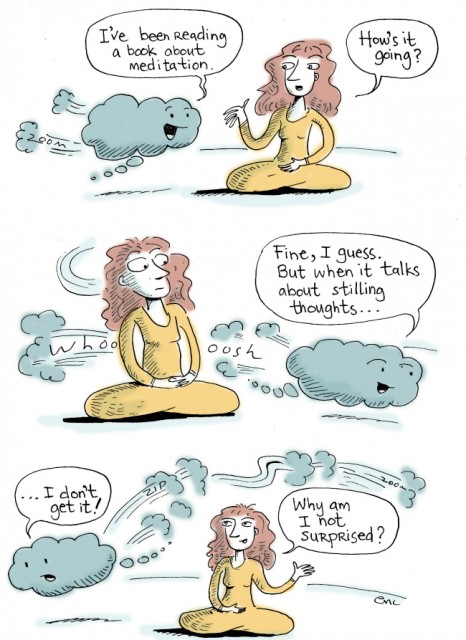
What is FOMO?
FOMO is an acronym for “fear of missing out.”
It’s a state of mind that has become pervasive in this age of social media and instant access. So pervasive, in fact, that the acronym FOMO was added to the Oxford English Dictionary in 2013.
So, how does FOMO operate in daily life?
Let’s imagine that we’re eating a salad.
We’re enjoying it, but then we glance at our Instagram or Facebook feed. And there it is: a more perfect salad.
A salad that was hand-washed by chanting monks, anointed in holy oil and dusted with longevity-enhancing herbs gathered in the rainforest. A salad that someone else is eating. And we’re not.
We chew our pathetic lettuce.
We can barely choke it down. Our throat is constricted with grief, envy and hopelessness. Everything about our salad reminds us of how small our life is. How much we’re missing.
Welcome to FOMO-mind.
FOMO-mind doesn’t just ruin our dinner; it makes every experience a disappointment. FOMO-mind erases the present moment and replaces it with images—fantasies—of what we’re missing, how we’re lacking, and why we’re less than.
Even the world of spiritual practice is not exempt from FOMO-mind.
One of the amazing blessings of our time is that we have access, as never before in history, to sacred teachings.
With the click of a mouse, we can download texts and teachings that, for centuries, were only available to those few seekers able to leave their lives behind and enter ashrams, monasteries and full-time spiritual practice.
Not anymore.
We don’t have to climb mountains.
We can listen to the most esoteric teachings without getting up off the couch. We can hear mediations and dharma talks, and take yoga classes whenever and wherever we choose.
This access to spiritual teachings is an amazing blessing. And it presents a unique challenge—particularly in this age of FOMO.
When we’re lost in FOMO-mind, we can’t settle down.
We can’t settle into a practice and deepen our experience when we’re chanting the FOMO mantra, “What am I missing? What am I missing?”
The FOMO mantra reinforces a sense of dissatisfaction and disappointment, which distracts us from the blessing of our present moment experience—whether we’re chewing on a salad or meditating on a sutra.
It keeps us clicking.
Clicking from talk to talk. From workshop to workshop. From practice to practice.
Here’s how folks described FOMO in the Wisdom Heart survey:
I get distracted… start on one path, then oops there’s another path, that feels right, oh, here’s one that’s interesting, hmmm.
I have access to a lot of meditations, so I sometimes do one and sometimes another. Does that make it harder to progress?
Hmmmm, indeed. Feel the power of FOMO?
Feel how skipping and clicking from practice to practice intensifies the experience of dissatisfaction?
How can we focus and go deep when we’re chanting the mantra of distraction?
We can’t. FOMO isn’t designed for focus, depth or fulfillment.
And yet, FOMO brings a blessing.
What’s the blessing of FOMO?
Hidden beneath the twitchy, superficial sense of “What am I missing?” is a deeper longing, an authentic dissatisfaction.
There is something real that our soul is seeking. There is something authentic that has caused us to collect all those spiritual books, courses, programs, workshops. It’s that true longing that we’re here, in this life, to satisfy.
But, FOMO doesn’t allow us to feel that authentic dissatisfaction.
It doesn’t let us settle in. To scratch our soul’s real itch. To go deeper.
FOMO keeps us bouncing on the surface, so we can’t experience the true and necessary discomfort that is part of the awakening process.
Yes, there is a true and necessary discomfort that cannot be avoided. As Viktor Frankl has written, “What is to give light must endure burning.”
There is a burning dimension to the path.
FOMO-mind doesn’t appreciate burning. When things heat up, it clicks away. But, that clicking away never satisfies.
There’s a burning that arises when we heed and follow the call of our soul.
Everything heats up as we move more deeply into our life.
Our mind, emotions, body, relationships—everything becomes part of the fire. Everything is burning.
In the ancient language of Yoga, this fire is called tapas. It’s the fire that accompanies times of transformation as we more fully embody authenticity, aliveness and awareness in our life.
The fire is not to be avoided.
The fire is there to teach us, purify us and transform us.
For the teaching, purifying and transforming to unfold, we can’t click away.
Don’t click away. Instead, be still. Open. Keep breathing.
Here’s the practice: Assent to the fire, and let it do the work.
That’s enough.
You don’t have to do the transforming.
You can’t.
You—the conditioned you—only knows the FOMO mantra in all its self-limiting forms.
As you settle down, the FOMO mantra may grow louder.
Just notice that. This is part of the process. You don’t have to fix it.
The fire of awareness does all the work. Your role is to stay present. To allow that which is being burned up to do so.
What’s burned up in the fire?
Outmoded self-images. Ways of imagining who and what you are, which includes ideas about what you’re missing.
And as these self-images dissolve away, the fire reveals deeper teachings: you are not your self-images.
You are not the ideas, projections, hopes or fears you have had about yourself.
Settle down. Open.
Listen to the fire that’s burning, calling, whispering in your heart: you can’t miss out.
~
Relephant Read:
The Loving Art of Letting Go.
~
Author: Eric Klein
Editor: Toby Israel
Image: Author’s Own
~











Read 0 comments and reply